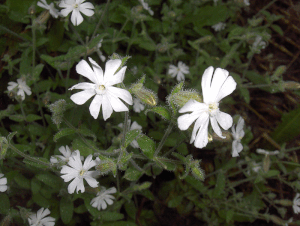Field carnation
| Field carnation | ||||||||||||
|---|---|---|---|---|---|---|---|---|---|---|---|---|

Light carnation ( Silene noctiflora ) |
||||||||||||
| Systematics | ||||||||||||
|
||||||||||||
| Scientific name | ||||||||||||
| Silene noctiflora | ||||||||||||
| L. |
The Acker-campion ( Silene noctiflora ) even night Blooming campion or campion called, is a plant from the family of the Pink family . Only in the late afternoon do the flowers unfold and give off their sweet, clover-like scent, which attracts the moths. The plant is regarded as a “ weed ”, but is considered endangered in the Alpine region.
description
Vegetative characteristics
The light carnation is an annual herbaceous plant and reaches heights of 15 to 50 (to 90) centimeters. A tap root is formed. The above-ground parts of the plant are densely hairy with glands. The upright stem usually grows unbranched to not very branched.
Their opposite leaves are simple, oblong, egg-shaped, up to 11 cm long and they are pointed at both ends. The upper leaves and the upper stem area are sticky, densely hairy.
Generative characteristics
The flowering period extends from June to September. In the leaf axils in the upper area of the stem, small, little-flowered, dichasial, zymous inflorescences are formed. The upright peduncle is shorter than the calyx.
The hermaphrodite flowers are radially symmetrical and five-fold. Five light green sepals are fused into a 2 to 2.5 (to 3) cm long and about 5 mm wide, ten-nerved calyx. The white, creamy-white to pink-colored petals form a crown, which when open has a diameter of up to 3 centimeters. Each of the five petals is deeply lobed in two columns. A secondary crown is formed. Each flower contains three styles; they are shorter than the petals. Although the flower is hermaphroditic, the plant rarely pollinates itself, as the anthers are open several days before the stigmas are fully formed.
The egg-shaped capsule fruit opens at the top with usually six outwardly curved teeth. Through this opening it releases many kidney-shaped gray-orange seeds about 1 millimeter in size.
The basic chromosome number is x = 12; there is diploidy , i.e. 2n = 24.
ecology
The field light carnation is a deciduous, mesomorphic, scleromorphic therophyte . It is rooted up to 55 centimeters deep.
It blooms at night, hence the specific epithet noctiflora . They are pollinated by insects , largely by moths , as their flowers only open towards evening. Insects that land on the plant are held in place by its sticky hair. Most of them can break free again, but become sticky in the process, so that the pollen sticks to them when they visit the flowers again.
Propagation occurs through self and wind propagation . Propagation takes place exclusively through seeds.
Occurrence
Silene noctiflora is common in the temperate latitudes of Europe and Asia. The main focus is on Central and Eastern Europe . Through human activities, she is now a neophyte in North America and New Zealand.
This lime-loving plant is mainly found in fields and fallow land . According to the ecological indicator values according to Ellenberg , this species is specified as a penumbral plant for a moderate to warm sea climate. It thrives best on dry, damp, calcareous and moderately nitrogenous soils . In Central Europe it is a character species of the Papaveri-Melandrietum noctiflori from the Caucalidion association. It occurs in smaller groups or as a single specimen.
Taxonomy
The first publication of Silene noctiflora was in 1753 by Carl von Linné . Synonyms for Silene noctiflora L. are for example: Elisanthe noctiflora (L.) Ruprecht and Melandrium noctiflorum (L.) Fries .
Others
There is no known use of this species. It is seen as a " weed ".
Sources and further information
The article is mainly based on the following documents:
Individual evidence
- ↑ a b Silene noctiflora L., catchwort. In: FloraWeb.de.
- ↑ Oskar Sebald : Guide through nature. Wild plants of Central Europe. ADAC Verlag, Munich 1989, ISBN 3-87003-352-5 , p. 71.
- ↑ G. Tischler: The chromosome numbers of the vascular plants of Central Europe . 's-Gravenhage, junk. 1950.
- ↑ a b field light carnation . In: BiolFlor, the database of biological-ecological characteristics of the flora of Germany.
- ↑ a b Erich Oberdorfer : Plant-sociological excursion flora for Germany and neighboring areas . With the collaboration of Angelika Schwabe and Theo Müller. 8th, heavily revised and expanded edition. Eugen Ulmer, Stuttgart (Hohenheim) 2001, ISBN 3-8001-3131-5 , pp. 365 .
- ^ A b Silene in the Germplasm Resources Information Network (GRIN), USDA , ARS , National Genetic Resources Program. National Germplasm Resources Laboratory, Beltsville, Maryland. Retrieved September 9, 2017.
Web links
- Distribution map for Germany. In: Floraweb .
- Profile and distribution map for Bavaria . In: Botanical Information Hub of Bavaria .
- Silene noctiflora L. In: Info Flora , the national data and information center for Swiss flora . Retrieved October 8, 2015.
- Thomas Meyer: Data sheet with identification key and photos at Flora-de: Flora von Deutschland (old name of the website: Flowers in Swabia )
- Zhou Lihua, Magnus Lidén, Bengt Oxelman: Silene. : Silene noctiflora , p. 83 - the same text online as the printed work , In: Wu Zhengyi, Peter H. Raven, Deyuan Hong (ed.): Flora of China. Volume 6: Caryophyllaceae through Lardizabalaceae , Science Press and Missouri Botanical Garden Press, Beijing and St. Louis 2001, ISBN 1-930723-05-9 .
- Profile at the Natural History Museum Vienna.
- Characteristics at Ontario weeds (Engl.)
- Area map at "Den virtuella floran" (swed.)



